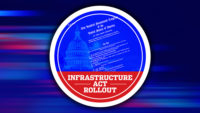The Obama administration is expanding its efforts to speed up federal regulatory reviews for major infrastructure projects, with modest changes to existing “streamlining” tools.
The actions, which the White House announced on Sept. 22, include widening the scope of the Dept. of Transportation’s four-year-old project-permit “dashboard,” which tracks large projects as they move through environmental and other regulatory studies.
In addition, administration officials have updated the “Red Book,” a 30-year-old federal guide that outlines ways for agency officials to expedite environmental studies. The document—Synchronizing Environmental Reviews for Transportation and Other Infrastructure Projects—hadn’t had a rewrite since 1988.
A White House memo said the project dashboard, which originated at DOT, now will cover non-transportation projects managed by 10 other agencies, including the Army Corps of Engineers, the Energy and Defense departments and the Environmental Protection Agency.
Construction industry officials have complained for years that federal reviews take much too long, delaying highway and other projects and raising their price tags.
A particular gripe is that when multiple agencies examined a project, their studies tended to be done one after another instead of simultaneously.
Industry advocates in Congress included project “streamlining” provisions in the 2012 MAP-21 highway-transit law and 2014’s Water Resources Reform and Development Act.
The George W. Bush administration acted to promote project “streamlining” and Obama has moved on the issue, signing a 2012 executive order to accelerate infrastructure projects and permit reviews. That was followed by a 2014 White House plan on permitting.
With the latest actions, DOT Secretary Anthony Foxx said, “We are pushing ourselves to improve efficiency, coordination and collaboration, so that federal permitting becomes a sprint rather than a relay race.”
Under the new dashboard directive, agencies will start in October to identify projects to be tracked and begin posting them on the dashboard within 90 days.
Some agencies already are on board. The dashboard as of Sept. 23 included projects being coordinated by the Corps, the Agriculture, Commerce, Interior and Energy departments, as well as DOT.
Projects must meet some criteria to get on the dashboard, the White House memo says. They must have a total cost of more than $200 million and involve at least two jurisdictions.
In addition, projects must go through at least two “complex” permitting and environmental reviews, such as Clean Water Act Section 404 wetlands permitting or Endangered Species Act consultations.
Brian Deery, senior director of the Associated General Contractors of America's highway and transportation division, says the items on the dashboard have tended to be megaprojects. “But there are still issues with smaller projects as well,” he notes.
“And there is some concern that if you put the focus of all these federal agencies on the big projects, then the next tier down of projects maybe get sort of pushed to the wayside and get less consideration than the megaprojects,” Deery adds.
He says reducing the threshold will cover many more projects, but also observes, “The $200-million project, that’s a hefty project in most neighborhoods.”
Deron Lovaas, the Natural Resources Defense Council's federal transportation policy director, said in an email that "beefing up the dashboard so it shows a bigger portfolio of federally funded projects and measures across agencies should go a long way towards reducing unnecessary delays without trading off environmental benefits."
The Red Book, AGC's Deery notes, originated with the Federal Highway Administration and the Corps. The new version was broadened to deal with railroad and transit projects. Deery also was pleased to see the latest edition goes beyond National Environmental Policy Act and Clean Water Act activities to include reviews under other statutes, such as the Endangered Species Act.
NRDC's Lovaas said that the changes in the Red Book appear to be useful "as long as synchronization is done [without] shortchangting individual agency reviews."
Story updated on 9/24/2015 to include NRDC comments.




Post a comment to this article
Report Abusive Comment